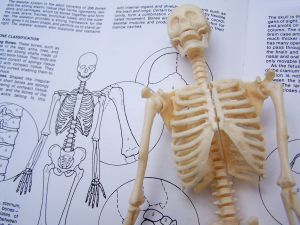 by Brooke Lieb
When people hear that I teach Alexander Technique, they often comment "Oh, that's about standing up straight", or say something apologetic or sarcastic. Then they inevitably pull themselves up into their version of "Good Posture".
by Brooke Lieb
When people hear that I teach Alexander Technique, they often comment "Oh, that's about standing up straight", or say something apologetic or sarcastic. Then they inevitably pull themselves up into their version of "Good Posture".
The good news is that gravity is not what's getting you down. It's actually your own muscles, over contracting, working inefficiently and pulling you down. When you learn to allow lengthening to occur throughout your musculature, weight falls more efficiently through bones and joints, leaving you more balanced on your skeleton.
Hours spent sitting at a computer, studying, driving a car and other such sedentary activities contribute to being habitually shortened through the muscles on the front of the body. Because we are so used to this shortening, it doesn't register in your feeling sense as active muscle work. In fact, it probably feels effortless and maybe even comfortable. Fortunately, when you learn to release this excess effort, the natural outcome is more evenly distributed muscle tone, lengthening and more upright alignment through your spine. You can get better results with less effort when it comes to posture.
I have a couple who've studied with me since Fall of 2000. He reported gaining a full inch in height at his last check up; and she went from a 1/4" to a 1/8" correction in her orthotics for a leg length discrepancy.
Studying the Alexander Technique can help you look taller and feel lighter and easier in upright posture.
I leave you with this quote:
"I am putting into gear the muscles that hold you up, and you are putting them out of gear and then making a tremendous effort to hold yourself up, with the result that, when you ease that effort, you slump down worse than ever." F. M. Alexander
[author] [author_image timthumb='on']http://www.acatnyc.org/main/wp-content/uploads/2014/01/Brooke1web.jpg[/author_image] [author_info]N. BROOKE LIEB, Director of Teacher Certification since 2008, received her certification from ACAT in 1989, joined the faculty in 1992. Brooke has presented to 100s of people at numerous conferences, has taught at C. W. Post College, St. Rose College, Kutztown University, Pace University, The Actors Institute, The National Theatre Conservatory at the Denver Center for the Performing Arts, Dennison University, and Wagner College; and has made presentations for the Hospital for Special Surgery, the Scoliosis Foundation, and the Arthritis Foundation; Mercy College and Touro College, Departments of Physical Therapy; and Northern Westchester Hospital. Brooke maintains a teaching practice in NYC, specializing in working with people dealing with pain, back injuries and scoliosis; and performing artists. www.brookelieb.com[/author_info] [/author]

 by Witold Fitz-Simon
Every one of us has a "sixth sense." Unfortunately, it's nothing fancy. It's not telepathy, or the ability to see ghosts, or anything supernatural like that. It is pretty cool, in its own way, even though most of us take it completely for granted most of the time. Our sixth sense is a "feeling" sense made up of information we get from our bodies.
by Witold Fitz-Simon
Every one of us has a "sixth sense." Unfortunately, it's nothing fancy. It's not telepathy, or the ability to see ghosts, or anything supernatural like that. It is pretty cool, in its own way, even though most of us take it completely for granted most of the time. Our sixth sense is a "feeling" sense made up of information we get from our bodies. by Dan Cayer
by Dan Cayer